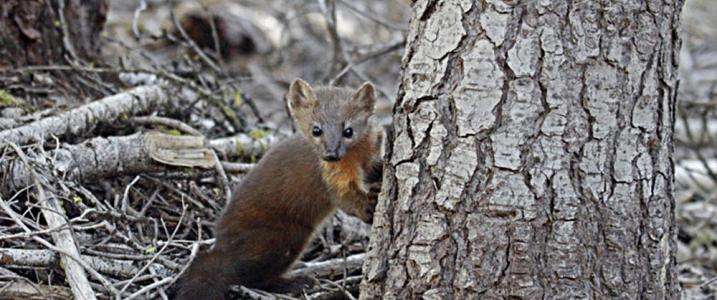Study shows forest thinning changes movement patterns, habitat use by martens

Scientists who for the first time used global positioning system (GPS) telemetry to monitor the movements of reclusive Pacific martens have discovered that these fierce, tiny mammals tend to avoid open stands of trees resulting from forest thinning.
That could put conservation efforts to protect martens at odds with modern forest management, but the researchers say there is a prescription that may work for both interests: maintaining forest thinning at lower elevations, which are less favored by martens, and preserve more high-elevation forests – which are at less risk for catastrophic wildfire – as complex, marten-friendly stands.
Results of the research, which was conducted in northern California, have just been published in the Journal of Wildlife Management.
"There are two main reasons that martens avoid open forests," said Katie Moriarty, a post-doctoral research biologist with the U.S. Forest Service, who conducted the research as a doctoral student at Oregon State University. "Martens eat a lot of food – up to a quarter of their body weight a day. It would be like you eating 100 hamburgers. They need downed logs and dense sapling cover to hunt successfully.
"Since they are the size of a gray squirrel, the woods are a dangerous place. They need to avoid being eaten. And for them, a wide-open forest is like being dropped into Jurassic Park filled with velociraptors. They just won't stay in those areas."
The study is important because Pacific martens are considered an indicator species for ecosystem health, said Clinton Epps, an associate professor in OSU's Department of Fisheries and Wildlife and co-author on the study. The key to the research was the use of GPS to observe a finer scale of the martens' movements.
"We were able to collect the locations of tagged martens so frequently that we could infer their movements through tree stands rather than relying on a typical radio telemetry study," Epps said. "There was clear evidence that their movement is affected by forest characteristics in different seasons.
"The spatial configuration of habitat is very important in these systems, even at the scale of an individual animal's movement. The martens typically avoided simplified stands and they behaved differently if they used them."
Much of the research was conducted in Lassen National Forest, which has the lowest documented annual survival rates for martens in North America – about 37 percent of them die each year. Forest lands are actively thinned, Moriarty said, although there is no established link between the survival rate and forest management practices. "We can't assume a causal relationship," she said.
What the researchers can document is how martens move through different forest types.
"Martens strongly selected complex forest stands over simple stands and openings," said Moriarty, who is with the Forest Service's Pacific Northwest Research Station in Olympia, Washington. "Their movements were slower and more sinuous in complex stands with lots of cover. When they were in the open, their movements were more erratic and linear. Those altered patterns of movement in open forests appear to negatively affect the ability of martens to forage without increase risk of predation."
Martens are one of the smaller members of the weasel family, weighing between one and two-and-a-half pounds – and they look something like a cross between a fox and a mink. Martens are "smaller than a Chihuahua," Moriarty said, "but have the attitude of a pit bull. They really have a little man's complex."
Small but fierce predators, martens feast on snowshoe hare, chipmunks, voles and other small mammals, and also consume bird eggs and berries. They can survive rugged winters with snow more than a dozen feet deep.
"If martens are thriving in an area, that usually is a sign of a healthy ecosystem," Moriarty said.
Moriarty's work has paid off in more than one way. In 2008, while studying martens in Tahoe National Forest, she gathered photographic evidence of a wolverine – the first sighting of the animal in California in 75 years.
Journal information: Journal of Wildlife Management
Provided by Oregon State University

















